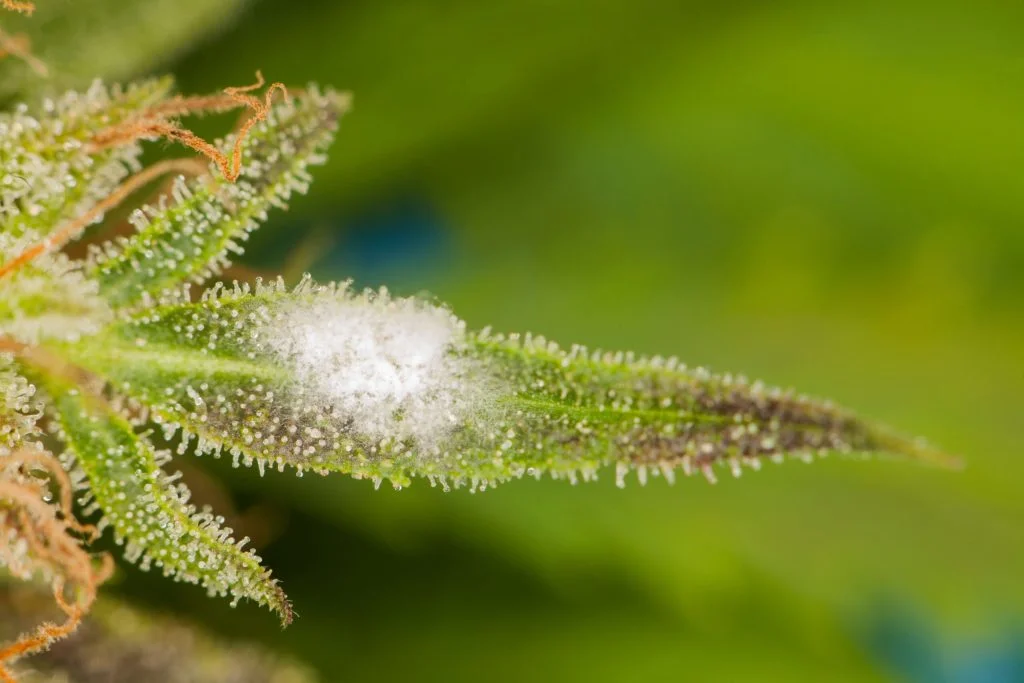Table of Contents
ToggleAs much as we’d like to think that cannabis is perfect all the time, unfortunately, some buds can get bad. In fact, finding mold on weed may be a bit more common than you’d think.
While the thought of moldy weed is undoubtedly unpleasant, it’s important to understand where this bacteria came from — and how to stop it from happening again.
Today, let’s take a closer look into mold on weed, how it formed, and how to spot it on your own bud at home.
Mold on Weed: How Does This Happen?
If you’ve had the misfortune of breaking up your weed only to find mold in it, there’s a good chance that it wasn’t your fault.
Typically, mold on weed happens due to the result of the growers themselves. Mold can grow if the buds didn’t get dried properly at the end of their harvest. Excess moisture was likely retained and, like with most undried moist things, the bud ended up growing mold. Gross.
Mold can also occur during the transportation process of the flower to the dispensaries. If the company transporting the cannabis doesn’t have it in proper packaging, and the climate they are going through is wet, this can also create mold spores.
If you’ve stored your cannabis for a long time and have come back to it no longer looking or smelling like it once did, you may have some moldy weed on your hands.
Unfortunately, mold on weed can occur because of improper storage, as well.

As you could probably tell, cannabis is averse to wet climates. When storing your cannabis products of any kind, you want to keep them in airtight containers and out of any moist air. Dry areas are going to be your bud’s best friend.
You should avoid places like basements, laundry rooms, and bathrooms when storing your weed. These areas tend to collect quite a bit of moisture, putting your weed at risk of growing mold.
There are a few other ways that your flower may have grown mold, including during the cultivation process. However, when it boils down to it, improper storage and drying tend to be at the root of it all.
This should go without saying, but if you have moldy weed, do not smoke it.
Smoking moldy bud can cause serious health problems, especially in the lungs. If you come across it in your flower, your flower should go straight in the trash.
What Does Mold Look Like on Weed?
Now that you know why your weed may have had mold, let’s talk about how to identify mold on weed. This is integral in staying happy and healthy with your cannabis consumption.
Moldy weed can look a few different ways depending on the type of mold that your plant has grown. The most common type of mold on weed is going to resemble a bit of a white, powdery substance across the flower.
Many people describe this type of mold on weed as looking similar to a light layer of dust. So, if you think your bud just has a bit of dust on it, think again: this could easily be mold.
Your cannabis could also get a different type of mold, one that looks closer to cotton growing within your buds. When you break open a nug, you’ll find white, gray, green, brown, or yellow cotton-like growths within your plant.
Along with this, this type of mold also puts off a very strong musty smell that’s quite different from the scent that a typical cannabis flower emits. When in doubt, smell it out.
Checking Your Weed for Mold
You’re probably a bit worried about mold in marijuana now, and we don’t blame you. So, how do you check for moldy buds?

As we’ve discussed, mold on weed is going to come with a subtle appearance that you can detect just with the naked eye.
First things first, do a thorough inspection of your flower. Does it look white and powdery at all? Does it feel too moist? Flower should crumble easily in the hand.
After you’ve looked at your bud, you can always do the smell test. Mold smells, well, moldy, and it’s easy to pick up when you’re familiar with the pungent smells of cannabis.
If you take a whiff of your flower and it smells like your grandma’s basement, that’s some moldy weed you got there.
For extra precautions, you can also get a hold of your flower’s certificate of analysis (COA). Every good cannabis product should come with a COA that demonstrates quality and purity — as well as be tested for moisture content and water activity.
If you view the COA and see high moisture content, then you know that there’s a chance you’ve got moldy weed — or at least, will soon.
Mold on Weed vs. Trichomes
Quickly, it’s important for us to establish that there’s a huge difference between mold on weed and frosty weed.
Many people use the term “frosty” to describe cannabis strains that have high trichome content. Trichomes are the parts of the cannabis plant that produce compounds like cannabinoids, terpenes, and flavonoids.
The frostier a strain, the more pungent and potent it is said to be.
However, frosty weed is going to look like it’s coated in mini crystals. It’s not going to look white. Again, white-covered cannabis indicates there is mold on weed, not high trichomes.
For more information on frosty cannabis strains and what they look like, you can check out our blog here.
Avoiding Mold on Weed With the Help of Elevate Holistics
The cannabis plant is complex, to say the least. There’s a lot to learn, a lot to look out for, and a lot we’re still understanding.
But, here at Elevate Holistics, we are dedicated to providing you with the best, most knowledgeable cannabis experience possible.
Whether you want to know about mold on weed, frosty cannabis strains, what makes weed purple, or even the benefits of having a medical card, we have you covered.
The first step to getting your hands on high-quality (non-moldy) weed is to get your medical cannabis card. We can get you your MMJ card recommendation right from home within minutes.
The benefits of having your medical cannabis card are endless. If you want to save money, get high-quality products, and have priority service, click the link below to book an appointment.







